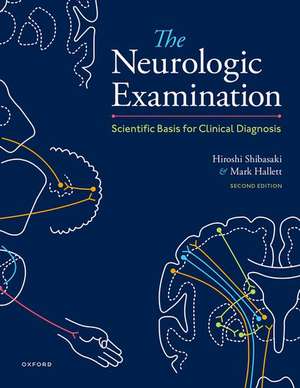The Neurologic Examination: Scientific Basis for Clinical Diagnosis
Autor Hiroshi Shibasaki, Mark Halletten Limba Engleză Hardback – 13 noi 2022
Preț: 883.40 lei
Preț vechi: 1046.78 lei
-16% Nou
Puncte Express: 1325
Preț estimativ în valută:
169.06€ • 178.79$ • 141.02£
169.06€ • 178.79$ • 141.02£
Carte disponibilă
Livrare economică 29 noiembrie-05 decembrie
Preluare comenzi: 021 569.72.76
Specificații
ISBN-13: 9780197556306
ISBN-10: 0197556302
Pagini: 348
Dimensiuni: 279 x 222 x 22 mm
Greutate: 1.23 kg
Ediția:2
Editura: Oxford University Press
Colecția OUP USA
Locul publicării:New York, United States
ISBN-10: 0197556302
Pagini: 348
Dimensiuni: 279 x 222 x 22 mm
Greutate: 1.23 kg
Ediția:2
Editura: Oxford University Press
Colecția OUP USA
Locul publicării:New York, United States
Recenzii
This is a great book for a professional neurologist wanting to brush up or learn from afresh, clinical signs that may be apparent or can be elicited from their patient. Sure, it is likely that neuroimaging may happen, but it is always useful and intellectually satisfying to go back to basics.
Notă biografică
Professor Hiroshi Shibasaki trained at Kyushu University Graduate School of Medicine, University of Minnesota, and the Institute of Neurology, Queen Square. He was Director of Human Brain Research Center (1990-2003) and Chairman of Neurology (1999-2003) at Kyoto University Graduate School of Medicine, Japan. He was Fogarty Scholar at NINDS, NIH, USA (2003 to 2005) and President of International Federation of Clinical Neurophysiology (2007-2010). Professor Shibasaki made many contributions to clinical neurophysiology and movement disorders and has been well known as an outstanding teacher. Professor Mark Hallett trained at Harvard Medical School, the National Institutes of Health, and the Institute of Psychiatry, London. He was at Harvard Medical School (1976-1984), and since then he has been Chief, Human Motor Control Section, NINDS, NIH. He has been President of the Movement Disorder Society, the American Association of Neuromuscular and Electrodiagnostic Medicine, theInternational Federation of Clinical Neurophysiology, and the Functional Neurological Disorder Society. He was Editor in Chief of Clinical Neurophysiology. He has trained many fellows from all over the world and made important contributions to the principles of human motor control and its disorders.
